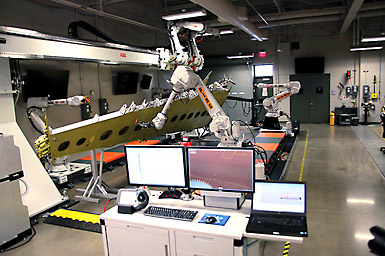At the same time, forward-thinking manufacturers understand that partnerships with public entities can accelerate and ease the cost of introducing complex new equipment and production processes into their plants. By examining two best-in-class examples, this article highlights ways in which supportive public-private partnerships can be established to help facilitate the promotion of advanced manufacturing. Each partnership helps companies improve productivity through either advanced manufacturing skills training or by offering advanced technological research development. This productivity improvement is the key to company survival, wage growth, and regional competitiveness.
Companies all too often must choose between introducing advanced manufacturing equipment and processes into existing plants or shutting down operations and beginning production somewhere else. During a recent engagement, Oxford Economics calculated that productivity in the U.S. advanced manufacturing sector is an estimated $226,071 per worker — more than twice the productivity of a worker in non-advanced manufacturing ($106,143). Higher worker productivity is typically associated with higher wages and educational attainment (or higher skills training), and our data supports that assertion. In a non-advanced manufacturing plant there are approximately three workers with no more than a high school education for every worker holding a bachelor’s degree (or higher). In contrast, that ratio is nearly one to one (high school educated worker to bachelor degreed worker) in advanced manufacturing plants. However, even in an advanced manufacturing plant, one third of all workers typically hold only a high school degree (and an equal number have less than a four year degree).
A Best-in-Class Example of Company Training
Let’s look at B. Braun Medical’s highly innovative program to train its existing workforce in the use and operation of the advanced manufacturing equipment that the company has been introducing to its Allentown, Pa., plant. B. Braun is one of the world’s leading manufacturers of medical devices. Like many other manufacturers, managers at the Allentown plant noticed a skills gap in their existing workforce as increasingly sophisticated equipment was introduced into plant operations. The company reviewed the key competencies that workers require in order to understand the theory of how the equipment works and the principles that govern line operations in an advanced manufacturing plant. These competencies include mechanical, electrical, hydraulic, and pneumatic functions. A Progression Based System (“PBS”) was introduced to make sure that all employees receive basic training in each of these functional areas. The underlying strategy behind PBS is to train all workers in these core competencies, and then help the employee learn to apply this theoretical background to the operation, maintenance, and repair of equipment in the plant.
Training is divided into five levels: entry, basic, intermediate, comprehensive, advanced (with a master’s level under development). The expectation is that each employee will advance to the comprehensive level. An estimated 90 percent of all current operations in the plant are covered at the comprehensive level. In other words, an employee completing the comprehensive level of training will possess the theoretical knowledge needed to understand (at the practical level) 90 percent of the plant’s production operations. Each level takes approximately one year to complete and training is done through a mix of company time and employee’s time (depending on the current level of the employee). All training was initially provided by a local vocational school but has since been expanded to include the local community colleges as well. PBS has allowed B. Braun to retrain and upskill its employees, and the better skilled workforce has, in turn, helped the company reduce its operating and maintenance costs. The program is now being introduced to other B. Braun facilities in the United States.
The success of B. Braun’s PBS program reflects, in part, upon its excellent relationship with the Lehigh Valley Workforce Investment Board (WIB). The WIB helped the company navigate different agencies; helped identify grants that offset some of the training costs associated with PBS; and put the company in close touch with the community’s K-12 educational leaders. Educating guidance counselors, students, and parents at the high school level about opportunities in advanced manufacturing is an important part of the company’s recruitment strategy.
Key to the program’s success was its design around carefully researched training needs. Too often, training providers and companies rely on anecdotal evidence or ready-made solutions without first undertaking the careful data-driven analytics necessary to ensure strategic alignment among employees, managers, training providers, and other interested partners. This data-driven foundation, in turn, accelerates the process of engagement, articulation, program development, and effective implementation strategies. The B. Braun program is a best-in-class example of a company training its core workforce in the skills needed to succeed in an advanced manufacturing environment.

The National Institute for Aviation Research (NIAR) at Wichita (Kansas) State University is a best-in-class example of a university supporting advanced manufacturing in its community by providing research and development services in key technological disciplines. From its inception in 1985, NIAR was organized to research and develop technologies identified by its industry advisory board (which is comprised of the vice presidents for engineering from many of the leading aviation and other advanced manufacturing companies in Wichita). NIAR is organized around labs that operate as independent business units. Labs open and close under the direction of NIAR’s advisory board, with each lab pursuing a specific technology identified by the board. This orientation around the research objectives of local industry (an industry-centric organizational approach) is quite different from the faculty-centric organizational approach found in many other offices of research and technology transfer (in which commercialization of faculty innovation is the primary objective).
Because each lab is self-funded, its research must be highly relevant to the advanced manufacturers whom it is organized to serve. Current labs, for example, are organized around additive manufacturing, computational mechanics, composites and advanced materials, and more than a dozen other cutting-edge technologies. Large capital expenditures (for state-of-the-art equipment) are typically priced into research and certification testing projects done for private clients, although approximately 15 percent of NIAR’s budget comes from the Kansas Aviation Research and Technology Growth Initiative. The university itself funds only a small amount of administrative overhead expense.
Higher worker productivity is typically associated with higher wages and educational attainment. One recent but not atypical success story involves Airbus Americas, a company with a large engineering presence in Wichita. NIAR’s initial relationship with the company was to provide Airbus engineers with training in composites and advanced materials. The relationship has since been expanded to include full-scale structural testing in Wichita (the first time this is being done by the company at locations outside of Europe).
NIAR provides a best-in-class organizational model for university-business partnerships in advanced manufacturing. It has applicability to any community with a large research university and a cluster of companies with common research needs. It may also have applicability to communities seeking to leverage the technological expertise found on large military bases. For example, one can easily imagine how (former) military personnel can be organized around technological competencies that are specific to the research and certification needs of military contractors (and civilian companies utilizing comparable technologies). The establishment of such a research institute in military communities might be an important first step in attracting the advanced manufacturing operations connected to the research and testing being conducted.
The experiences of B. Braun and Wichita State University demonstrate that best-in-class practices to promote innovative advanced manufacturing cultures within a community do not happen in a vacuum. They involve strategic planning and effective partnership with public institutions. Educational institutions — ranging from K-12 right through advanced university research programs — have a vital role to play. This article profiled effective partnerships in advanced manufacturing skills training and technological research and development. However, similar alignment is needed in energy, tax, and other regulatory arenas. But one critical lesson learned from the B. Braun and NIAR experiences is that best-in-class practices can only emerge when leading companies view local public partnerships as strategic and take the lead in making sure that their communities create environments that are supportive of advanced manufacturing.



